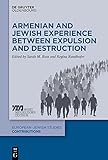Armenian and Jewish Experience between Expulsion and Destruction / ed. by Sarah M. Ross, Regina Randhofer.
Material type: TextSeries: Europäisch-jüdische Studien – Beiträge : Herausgegeben vom Moses Mendelssohn Zentrum in Kooperation mit dem Selma Stern Zentrum für Jüdische Studien Berlin-Brandenburg ; 51Publisher: München ; Wien : De Gruyter Oldenbourg, [2021]Copyright date: ©2022Description: 1 online resource (VII, 310 p.)Content type:
TextSeries: Europäisch-jüdische Studien – Beiträge : Herausgegeben vom Moses Mendelssohn Zentrum in Kooperation mit dem Selma Stern Zentrum für Jüdische Studien Berlin-Brandenburg ; 51Publisher: München ; Wien : De Gruyter Oldenbourg, [2021]Copyright date: ©2022Description: 1 online resource (VII, 310 p.)Content type: - 9783110695335
- 9783110695533
- 9783110695403
- online - DeGruyter
- Issued also in print.
| Item type | Current library | Call number | URL | Status | Notes | Barcode | |
|---|---|---|---|---|---|---|---|
 eBook
eBook
|
Biblioteca "Angelicum" Pont. Univ. S.Tommaso d'Aquino Nuvola online | online - DeGruyter (Browse shelf(Opens below)) | Online access | Not for loan (Accesso limitato) | Accesso per gli utenti autorizzati / Access for authorized users | (dgr)9783110695403 |
Frontmatter -- Table of Contents -- Broadening Perspectives. Introduction -- DIASPORA AND MINORITY ISSUES -- Identity and Migration -- Is Translation Diasporic? A Confrontation between Franz Rosenzweig and Yehuda Halevi -- Saint Vardan’s Day in the Diaspora and the Republic of Armenia: Similarities and Differences. The Use of Art, Literature, and Language in Celebrations -- Yiddish Songs as an Identificatory Idiom in the Diaspora: Die schönsten Lieder der Ostjuden, Arranged by Darius Milhaud, Stefan Wolpe, and Alvin Curran -- “If you see me walking alone on the road”: Sephardic Songs of Exile, Expulsion, Memory – and Return -- Experience of Alterity -- Jewish and Armenian Students at German Universities from the End of the Nineteenth Century and until the Outbreak of World War I -- “The Jews of Caucasus”: Perception of Armenians in the German and Polish Travel Literature -- “Natural Born Actors” on the Screen: Das alte Gesetz (1923) and the Theatricality of the Modern Jewish Experience -- AGHET AND SHOAH -- Experience – Memory – -- Self-understanding -- Between Armenian Praise and Zionist Critique: Henry Morgenthau and the Jews of the Ottoman Empire -- The Armenian Genocide and the Jewish Holocaust: Trauma and Its Influence on Identity Changes of Survivors and their Descendants -- Memory in Motion: Armenian Youth and New Forms of Engagement with the Past -- Cultural Representations: Identity -- Constructions and Negotiation Processes -- Collective Memory in Israeli Popular Music: (Re)constructions across Generations -- Historical Awareness in Zavèn Bibérian’s Autobiographical Longer Fragment: A Rare Perception of both Armenian and Jewish Sufferings -- “Global Solidarity is Something to Warm the Cockles of Your Heart”: Holocaust and Genocide in Ephraim Kishon’s “Israeli Satire” -- Persistent Parallels, Resistant Particularities: Holocaust Analogies and Avoidance in Armenian Genocide Centennial Cinema -- Contributors -- Authors -- Editors -- Index of Subjects -- Index of Names
restricted access online access with authorization star
http://purl.org/coar/access_right/c_16ec
Jews and Armenians are often perceived as peoples with similar tragic historical experiences. Not only were both groups forced into statelessness and a life outside their homelands for centuries, in the 20th century, in the shadow of war, they were threatened with collective annihilation. Thus far, academic approaches to these two "classical" diasporas have been quite different. Moreover, Armenian and Jewish questions posed during the 19th and 20th centuries have usually been treated separately. The conference “We Will Live After Babylon” that took place in Hanover in February 2019, addressed this gap in research and was one of the first initiatives to deal directly with Jewish and Armenian historical experiences, between expulsion, exile and annihilation, in a comparative framework. The contributions in this volume take on multidisciplinary approaches relating to the conference’s central themes: diaspora, minority issues and genocide.
Issued also in print.
Mode of access: Internet via World Wide Web.
In English.
Description based on online resource; title from PDF title page (publisher's Web site, viewed 02. Mai 2023)


